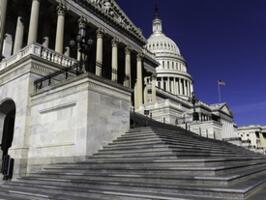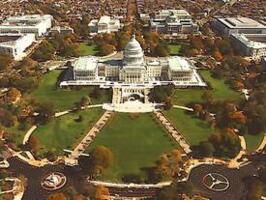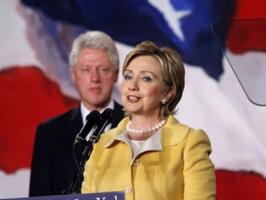Obama Equal Reagan? So Far, It Ain't Even Close
A Commentary By Lawrence Kudlow
A week after Ronald Reagan's 100th birthday celebration, comparisons between Presidents Obama and Reagan continue.
The conversation began when Obama praised Reagan in a USA Today op-ed. He commended Reagan's leadership, his confidence in and optimism for America, and his great ability to communicate his vision for the country. Reaganites like myself appreciate these sentiments.
But so far, the differences between the two presidents are still huge.
Begin with the economy. Reagan and Obama both inherited deep and brutal recessions. But the first six recovery quarters look completely different for each president.
So far, real gross domestic product has averaged only 3 percent annually for Obama. Employment as defined by nonfarm payrolls has increased by a paltry 121,000.
On the other hand, going back to Reagan's first six recovery quarters, real GDP averaged 7.7 percent annually, while nonfarm payrolls rose by 5.3 million.
No two situations are exactly alike. Reagan inherited massive double-digit inflation with 20 percent interest rates. Obama was left with a colossal financial meltdown. But Reagan's economic vision put private-sector free enterprise at the center. Obama has chosen a massive expansion of government power.
These are huge differences. One succeeded, while thus far the other has not.
While Obama's first act was an $800 billion government-spending package, one of Reagan's first decisions was a near $50 billion domestic-spending cut ($100 billion in constant dollars today). Obama went for a nationalized health care plan, energy cap-and-tax-and-trade and pro-union card check. Reagan ended wage and price controls, deregulated all energy prices, terminated the Synthetic Fuels Corp. and fired the striking air-traffic controllers. Big differences.
Drawing from the work of Arthur Laffer and Robert Mundell, Reagan saw the economic-growth benefits of limited government, lower tax rates and a dollar as good as gold. Gold prices plunged as Reagan and Paul Volcker worked to vanquish inflation. Ever-soaring inflation was the cruelest tax hike of all. But in the Reagan years, the inflation rate dropped from near 13 percent to as low as 2 percent -- a huge disinflation tax cut. Accompanied by lower marginal tax rates, the Reagan policies sparked a powerful recovery in business and jobs.
Reagan slashed tax rates across the board for individuals, investors and businesses. At the margin, his reforms lowered the top personal rate from 70 percent to 28 percent. And he left a simple two-bracket tax code that cut thousands of pages of IRS rules and regulations.
And while the top individual tax rate was slashed under Reagan, individual income-tax revenues increased from roughly $300 billion to $450 billion. In other words, the Laffer curve worked. With surging economic growth, the incentives from lower tax rates actually raised tax revenues.
Obama, on the other hand, campaigned to raise tax rates on successful earners and investors. Along with the dozens of taxes legislated into Obamacare, these are all job stoppers.
Only after the 2010 election landslide did Obama finally agree to extend the 2003 Bush tax rates for a couple of years. But he continues his pledge to hike those taxes again when the deal expires in 2012.
From his experience as a movie actor facing a 90 percent tax rate, Reagan always encouraged success. Everyone's success. And he came to believe that if it pays more after-tax to work and invest, then people will do so.
Of course, Reagan increased the defense budget to defeat the Soviets. But during the seven fat years of growth -- to use the late Robert Bartley's term -- overall federal spending dropped from 23 percent of GDP to 21 percent. (Obama has taken the size of government to 25 percent of GDP.)
As for the budget deficit, Reagan left it around 3 percent of GDP -- almost exactly where he inherited it.
Overall, Reagan's policies created 21 million new jobs, as real GDP averaged 3.5 percent annually during the seven fat years of recovery. The unemployment rate dropped to 5.3 percent from 10.7 percent. The stock market rose nearly 200 percent. And household net worth expanded by $8 trillion.
Quintessentially, Reagan was a private-sector, free-enterprise man. His policies of low tax rates, lighter regulation, domestic-spending limits and low inflation rescued the country from the malaise of stagflation. Meanwhile, his military build-up, tough diplomacy and "evil empire" battle cry defeated Soviet communism. Reagan was an optimist, but a tough-minded one. He believed in American exceptionalism. He also fervently believed in freedom.
Since last November's tea party election, Obama has read about Reagan, talked about Reagan and very cautiously moved economic policy in the direction of Reagan. I am open-minded. Let's hope the current president stays on his new Reagan path.
But let's never forget: Ronald Reagan saved the country 30 years ago. He also saved our future. Hopefully, Obama will learn from that.
COPYRIGHT 2011 CREATORS.COM
See More Commentary by Lawrence Kudlow.
See Other Political Commentary.
Views expressed in this column are those of the author, not those of Rasmussen Reports. Comments about this content should be directed to the author or syndicate.
Rasmussen Reports is a media company specializing in the collection, publication and distribution of public opinion information.
We conduct public opinion polls on a variety of topics to inform our audience on events in the news and other topics of interest. To ensure editorial control and independence, we pay for the polls ourselves and generate revenue through the sale of subscriptions, sponsorships, and advertising. Nightly polling on politics, business and lifestyle topics provides the content to update the Rasmussen Reports web site many times each day. If it's in the news, it's in our polls. Additionally, the data drives a daily update newsletter and various media outlets across the country.
Some information, including the Rasmussen Reports daily Presidential Tracking Poll and commentaries are available for free to the general public. Subscriptions are available for $4.95 a month or 34.95 a year that provide subscribers with exclusive access to more than 20 stories per week on upcoming elections, consumer confidence, and issues that affect us all. For those who are really into the numbers, Platinum Members can review demographic crosstabs and a full history of our data.
To learn more about our methodology, click here.



